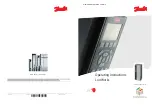
HYUNDAI SINGLE PHASE VECTOR INVERTER
18
|
19
Notes on Use: Installation Location and Operating Environment
Notes on Use: Main Power Supply
Notes on Peripheral Equipment Selection
•
Avoid installation in areas of high temperature, excessive humidity, or where moisture can easily condense, as well as areas that are dusty, subject to corrosive
gasses, mist from liquid used for grinding, or salt. Install the inverter in a well-ventilated and vibration-free room avoiding direct sunlight.
•
The inverter can be operated in an ambient temperature range of -10
℃
to 50
℃
(carrier frequency and output current must be reduced between 40
℃
to 50
℃
).
•
An inverter run by a private power generator may overheat the generator or suffer from a deformed output voltage waveform from the generator.
•
Generally, generator capacity should be at least five times that of the inverter (kVA) in a PWM control system, or six times greater
in a PAM control system.
Using a
private power
generator
Installation of
an AC reactor
on the
input side
(1) Be sure to connect main power cables to L1, L2 (input) terminals and motor to U, V, and W terminals (output).
(Incorrect connection will cause a breakdown.)
(2) Be sure to ground the inverter frame using the ground terminal.
If an electromagnetic contactor is installed between the inverter and the motor, do not perform on-off switching during running operation.
•
Install a circuit breaker on the main power input side to protect inverter wiring and ensure personal safety.
•
Choose an inverter-compatible circuit breaker.
If the earth leakage relay (or earth leakage breaker) is used, it should have a sensitivity level of 15 mA or more (per inverter).
Do not use a capacitor for power factor improvement between the inverter and the motor because the high-frequency
components of the inverter output may overheat or damage the capacitor.
Wiring connections
Wiring
between
inverter
and
motor
Installing a circuit breaker
Earth leakage relay
Phase advance capacitor
Electromagnetic contactor
Thermal relay
Wiring distance
•
High-frequency components are included in the input/output of the inverter main circuit, and they may cause interference in a transmitter,
radio, or sensor if used near the inverter. The interference can be minimized by adopting noise filters (option).
•
The switching action of an inverter causes an increase in leakage current. Be sure to ground the inverter and the motor.
•
Because a smoothing capacitor deteriorates as it undergoes internal chemical reaction, it should
normally be replaced every five years. Be aware, however, that its life expectancy becomes considerably
shorter when the inverter is subjected to such adverse factors such as high temperature, or heavy load
exceeding the rated current of the inverter.
•
Also, consumable parts such as cooling fans should be replaced according to the inverter periodic
inspection of the maintenance guide (maintenance inspection and parts replacement must be performed
by only specified trained personnel).
High-Frequency Noise and Leakage Current
Lifetime of Primary Parts
In the cases below involving a general-purpose inverter, a large peak current flows on the main power supply side, and is able to destroy
the converter module. Where such situations are foreseen or the connected equipment must be highly reliable, install an AC reactor between
the power supply and the inverter. Also, where influence of on indirect lightning strike is possible, install a lightning conductor.
(a) The unbalance factor of the power supply is 3% or higher(Note).
(b) The power supply capacity is at least 10 times greater than the inverter capacity (the power supply capacity is 500kVA or more).
(c) Abrupt power supply changes are expected.
examples
: (1) Several inverters are interconnected with a short bus. (2) A thyristor converter and an inverter are interconnected with a short bus.
(3) An installed phase advance capacitor opens and closes.
In cases (a), (b) and (c), it is recommended to install an AC reactor on the main power supply side.
When used with standard applicable output motors (Hyundai standard three-phase squirrel-cage four-pole motors), the N50 Series
do not need a thermal relay for motor protection due to the internal electronic protective circuit. A thermal relay, however, should be used:
(a) during continuous running at a range beyond 30 to 60 Hz.
(b) for motors exceeding the range of electronic thermal adjustment relay for each motor.
(c) when several motors are driven by one inverter; a thermal relay should be installed for each motor.
The RC value of the thermal relay should be more than 1.1 times the rated current of the motor. Where the wiring length is 10m or
more, the thermal relay tends to turn off readily. In this case, provide an AC reactor on the output side or use a current sensor.
•
The wiring length between the inverter and the remote operator panel should be 20 meters or less.
•
When this length is exceeded, use CVD-E (current-voltage converter) or RCD-E (remote control device).
•
Shielded cable should be used for the wiring. Be careful about the cable length to avoid line-voltage drop
(A large voltage drop causes a decrease in torque).
Summary of Contents for HiRun N50 Series
Page 1: ......


































